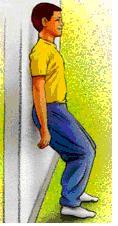Back pain amongst dentists is an increasingly common debilitating condition, causing substantial sick leave. However it is often a consequence of continued poor posture and awkward movements rather than injuries to the bones of the spine, therefore theoretically preventable. Poor posture causes unnecessary strain on the muscles and ligaments that support the lumbar region. Symptoms of back pain range from a sharp localised pain to a generalised ache in the lower back, with associated stiffness and difficulty in bending. However, if a disc prolapses and puts pressure on the lumbar nerves, causing sciatica, this pain may radiate down to the back of the leg to the foot and be accompanied by a “pins and needles” sensation. For a healthy and successful career in dentistry, it is imperative to be aware of how your posture or habits may be putting your back at risk.
How is back pain managed?
If symptoms arise, it is important to seek specialist medical advice from your General Practitioner, Chiropractor, Orthopaedics and Physiotherapists before acute problems become chronic. Dr D J Kanakum, a physiotherapist, who has been managing back pain for over 25 years now, advocates a management programme of firstly pain relief, i.e. for the first couple of days after a sudden injury, taking analgesics, massage and applying alternate hot and cold compresses to the affected area. Furthermore, the aetiology of the condition needs to be determined for successful management and prevention of further bouts of pain through practising strengthening exercises and utilising a memory foam mattress that supports the back. Surgery is the last resort.
How is back pain prevented?
Correct posture
In order to reduce the risk of back pain, an upright and straight posture whilst sitting is important when treating dental patients. The temptation to twist your back into an awkward position to gain direct vision of the tooth you are restoring should be avoided! Experiment with seating the patient in a different position and utilise your dental mirror as much as possible. Investing in a dental chair that adequately supports the back is also wise! Classes, such as Postural awareness, Yoga and Pilates, are now routinely available in gyms and may strengthen the back.
Seven basic principles of good posture for dentists include:
· The elbows are at 90 degrees.
· The shoulders are relaxed.
· The knees and hips are level or the knees are slightly lower.
· The back of the chair supports the small of the back.
· The height of the chair touches the tip of the shoulder blades.
· The feet rest on a foot rest if the legs are short or the chair is too high.
Preventative exercising
Lumbar spine stability is significantly dependent on supporting abdominal and low back musculature. Therefore, specialists recommend taking part in regular exercise, particularly cycling and swimming, to strengthen the lumbar region. However, certain sports, such as golf and racket sports, put extra pressure on the back, therefore should be avoided.
There is a vast support from medical literature of the benefits of specific physical therapy exercises for the treatment of lower back pain. An ongoing exercise program reduces the likelihood and severity of future occurrences of low back pain. Examples of upper and lower back exercises are pictorially illustrated below and these are recommended for dentists.
Strengthening upper back exercises

Strengthening lower back exercises:
Ankle pumps:

Lie on your back.
- Move ankles up and down. Repeat 10 times.
- Repeat 10 times.
Heel slides:

- Lie on your back.
- Slowly bend and straighten knee.
- Repeat 10 times.
Abdominal contraction:

- Lie on your back with knees bent and hands resting below ribs.
- Tighten abdominal muscles to squeeze ribs down toward back.
- Be sure not to hold breath.
- Hold 5 seconds.
- Relax.
- Repeat 10 times.
Wall squats:

- Stand with back leaning against wall.
- Walk feet 12 inches in front of body.
- Keep abdominal muscles tight while slowly bending both knees 45 degrees.
- Hold 5 seconds.
- Slowly return to upright position.
- Repeat 10 times.
Heel rises:

- Stand with weight even on both feet.
- Slowly raise heels up and down.
- Repeat 10 times
Straight leg rises:

- Lie on your back with one leg straight and one knee bent.
- Tighten abdominal muscles to stabilize low back.
- Slowly lift leg straight up about 6 to 12 inches and hold 1 to 5 seconds.
- Lower leg slowly.
- Repeat 10 times.
Forced early retirement due to back problems is a frequent occurrence and a growing concern amongst dental professionals. All the years of training are worth nothing if you can not hold up to the physical demands of dental practice. Through these preventative measures – postural awareness and exercises – back pain need not become chronic or recurrent. The suffering and financial costs saved by speedy action of back pain is incalculable.
References:
http://orthoinfo.aaos.org/topic.cfm?topic=A00302
 By Mahrukh Khwaja
By Mahrukh Khwaja